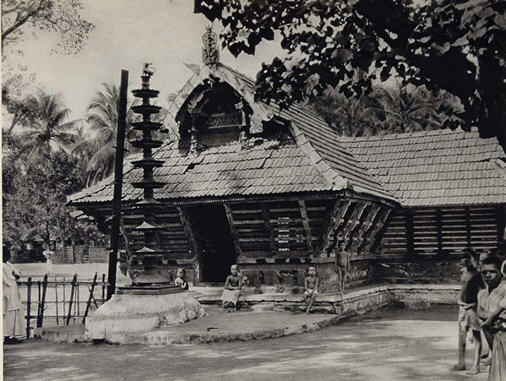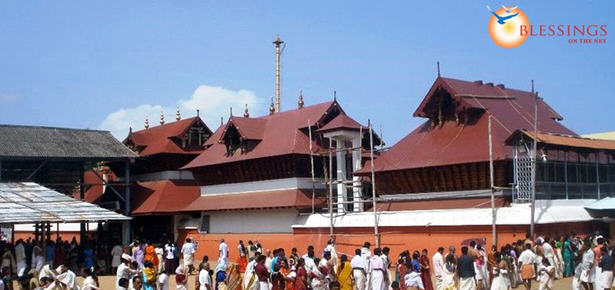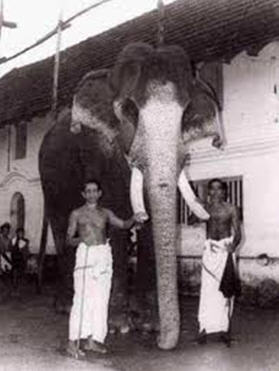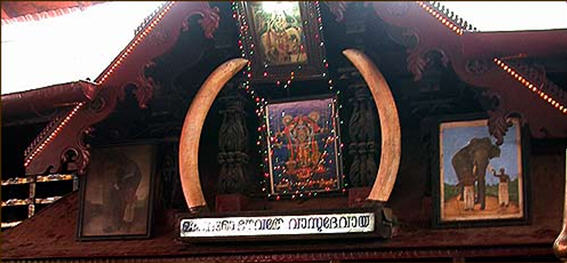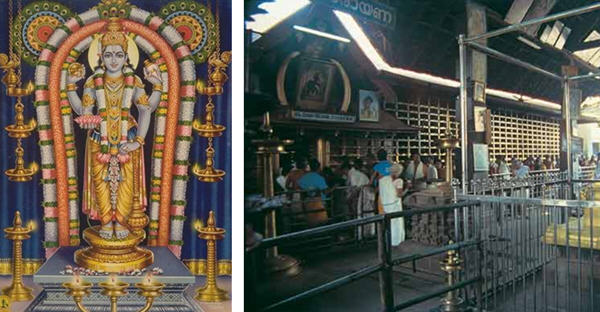
The system of rites conducted here is traceable to Sri Adi Sankaracharya.There are in all, 12 ‘darshan’ that can be had by a devotee on a given day. The timings mentioned are rough and based on a pamphlet published by the GuruvayurDevaswam (the body that administers the temple) for the guidance of the devotees.
The NIRMALYA DARSHAN (3 A.M to 3.20 A.M) is the first of the day. The Lord now is still adorned with the flowers and garlands of the previous night. It is believed that after the night pooja (worship), when the doors are closed, the devas (gods) come and worship the deity. A darshan of the Lord who has just been worshipped by the devas themselves is considered highly auspicious. Amidst the lit lamps, the chiming bells and the conch, the spontaneous cries of the devotees shouting out “Narayana”,”Guruvayurappa”,”Govinda”,etc., the innermost recesses of your mind will be lifted to the heights of devotion.
THE THAILABHISHEKAM, VAKACHARTH & SANKABHISHEKAM (3.20 A.M TO 3.30 A.M): The rite of bathing the deity with gingely oil takes place after removing the adornments of the previous day. Then comes Vakacharth i.e. sprinkling the deity with the vaka powder. The cork tree called vaka, is powdered and used. After this is performed, the abhishekam (rite of bathing the deity) with water sanctified in a sankhu (conch) is carried out.
ALANKARAM & MALAR NIVEDYAM (3.30 A.M TO 4.15 A.M) After the bath the Deity is wiped with a thin cloth ,then adorned with garlands, ear ornaments, Kasthuritilaka and a red loincloth. Butter in hand and playing the flute, the Lord here appears as Unnikrishna (child Krishna), reminiscent of His playful days at Gokul. After the alankaram (adornment or decoration),the malar naivedyami.emalar (puffed rice), plantain and jaggery are offered to the Lord.
USHA NAIVEDYAM & USHA POOJA (4.15 AM TO 4.30 AM) Offerings of cooked rice and naipayasam (rice cooked in jaggery constitute the ushanaivedyam (morning offering). The UshaPooja (morning worship) is also conducted at this time.
ETHIRETTU POOJA (4.30 AM to 6.15 AM) Now the Lord and the Sun are facing each other and pooja is performed by offering vellanaivadyam (white offering i.e. of cooked rice); simultaneously, the other deities in the temple are attended by associate priests. Ganapathyhomais performed in the temple kitchen.
SIVELI (6.15 AM to 7.00AM) The Srikovil (Sanctum sanctorum) opens allowing the devotees to have their darshan. The deity is then taken out for the Siveli (procession). The utsavavigraha (processional deity) is mounted in an elephant and taken round the temple thrice. Believably, the Lord want this exercise to be done so that He himself can ascertain if His cetestialattendents are keeping well.
It is here that the MelpathurNarayanaBhattathiri composed his Sanskrit devotional poem called Narayaneeyam. The temple is well-known for its healing powers and is the site for Annaprasanam, the first rice-giving ceremony of a child. Every year, the 28th of Malayalam month Vrischikam is celebrated as Narayaneeyam Day. In 2010, Narayaniyam Day is on 14th December 2010.
Offerings
Devotees conduct Tulabharam where a devotee is weighed against his choice of material. Some of the common items used for Thulabharam include banana, sugar, jaggery, coconut, or gold. Besides Tulabharam, elephants are also offered to the Lord. The feeding of these elephants is called Anayoottu. Other offerings include Prasadaootu, Alroopams, Picking up Kunnikkuru and Sayanapradakshina.
Opening and Closing Timings of Guruvayur Temple
Guruvayur Temple opens daily at 03:00 AM with NirmalyaDarshan and will be closed at 12:30 PM. The temple reopens at 4:30 PM and closed at 09:15 PM.
Please note that the Temple timings may change on certain special occasions and also if there is any Udayasthamanapooja.
For stories of personal experiences in Guruvayurpls visit http://www.guruvayoor.com/experiences.htm
Elephant Sanctuary
The elephant sanctuary at PunnathurKotta which is 3 km from Guruvayur is worth visiting. This is the largest elephant sanctuary and the elephants were offered by the devotees of the Lord. Gajapooja and Anayoottu (elephant feeding) are conducted here.
·Dress code for entering the temple
Strict dress code exists for people who wish to enter the Guruvayur Temple. Men are to wear mundu around their waist, without any dress covering their chest. But it is allowed to cover the chest region with a small piece of cloth (veshthi). Boys are allowed to wear shorts, but they are also prohibited from wearing a shirt. Girls and women are not allowed to wear any trouser like dresses or short skirts. Women are allowed to wear sari and girls are to wear long skirt and blouses. Presently the dress code for women have been relaxed with shalwarkameez (churidarpyjamas) being allowed.[12] Unlike in northern India, in Kerala and other southern Indian states Hindu women do not cover their heads in temples. Like all other temples in India, footwear is strictly prohibited. Security restrictions prevent carrying of mobile phones or cameras into the temple.
